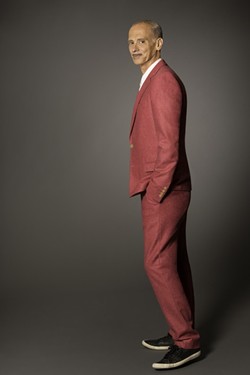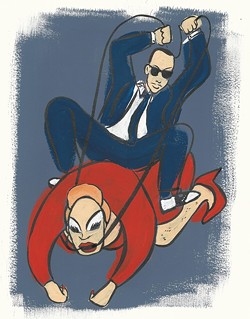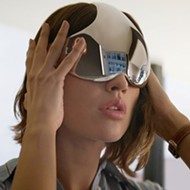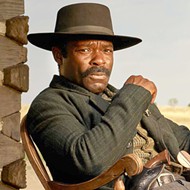Making bad taste more respectable: Cult filmmaker John Waters brings his one-man show to SLO
By Anna Weltner[{
"name": "Ad - Medium Rectangle CC01 - 300x250",
"id": "AdMediumRectangleCC01300x250",
"class": "inlineCenter",
"insertPoint": "8",
"component": "2963441",
"requiredCountToDisplay": "12"
},{
"name": "Ad - Medium Rectangle LC01 - 300x250",
"id": "AdMediumRectangleCC01300x250",
"class": "inlineCenter",
"insertPoint": "18",
"component": "2963441",
"requiredCountToDisplay": "22"
},{
"name": "Ad - Medium Rectangle LC09 - 300x250",
"id": "AdMediumRectangleLC09300x250",
"class": "inlineCenter",
"insertPoint": "28",
"component": "3252660",
"requiredCountToDisplay": "32"
}]
John Waters started his career as a trash-cinema auteur at the tender age of 16. In his early years, he made films with all the cheery plasticity of ’50s and ’60s America and lurid imagery of B-horror movies, starring a rotating cast of Baltimore misfits known as the Dreamlanders. His biggest star, however, was the plus-sized drag queen Divine, who starred in Mondo Trasho (1969), Multiple Maniacs (1970), the notorious Pink Flamingos (1972)—in which Divine famously ate dog poop, securing the film’s dubious underground acclaim—Female Trouble (1974), Polyester (1981), and, at last, 1988’s Hairspray, the breakthrough Waters film that somehow became a family-friendly Broadway musical.
Waters hasn’t made a film in 10 years, but he’s kept busy, whether hitchhiking across America (turns out it was research for a forthcoming book called Carsick), making visual art that’s just as cheekily awesome as his films, or performing his ever-changing monologue, This Filthy World.
On Tuesday, Feb. 25, he’ll bring the one-man show to the Fremont Theater. At New Times, we always jump at the chance interview Waters, who always has some bizarre wisdom to impart. This phone interview, which he gave from his home in Baltimore, was no different.
I. DRUNK WALKING
WATERS So, I almost got arrested for drunk walking in San Luis Obispo.
NEW TIMES Yes! I have heard this legend!
WATERS I was so shocked. I was visiting the prison there, had some drinks later, and I was walking back to my hotel. And I wasn’t even that drunk! I wasn’t staggering or anything. But I’m walking and this police car pulls up and is, you know, trailing me, sort of tracking me. And he said, “Have you been drinking?” I said, “Well—yes!” He said, “Well, you can’t be drinking and walking.” I said, “You can’t? I thought that was the whole point! That I wouldn’t be driving!” And that’s the first time ever in my entire life that I’ve almost been arrested for walking while impaired. And I wasn’t like rubber-legged or anything. I might have been weaving a little. That’s a weird police memory. Another time I was in Key West, and I was sitting on the beach with Divine—this was really a long time ago—and Divine was very fat, but he had on a little man’s bikini, but the fat hung over, so it looked like he was nude. I was very skinny, like speed-freak skinny, and long bacon-y hair, and the police came over and said, “You all just can’t sit over here looking like that.” I said, “What do you mean?” And he said, “No, no. You can’t be on the beach looking like that.” And later I realized he was right. But it did make me laugh. So those two police memories are the most startling memories I have. San Luis Obispo is where I hitchhiked and visited the prison.
NEW TIMES What were the circumstances of visiting the prison?
WATERS Oh, I had a friend that was in there. And I talked at prisons a lot. I still visit prisons a lot.
II. EVERYBODY SHOULD HITCHHIKE
NEW TIMES What is your life like these days? What is the life of John Waters?
WATERS I live on the road. I’m going to Berlin, where I have two art shows. And I’m doing a lecture tour, End of This Filthy World. And then I come home, and I go to L.A. to interview Jeff Koons onstage for the Eli Broad museum opening. I live on the road, really. But I’m at home in Baltimore at my house right now. My hitchhiking book, Carsick, comes out in June, so I’m doing a tour for that.
NEW TIMES Maybe we should touch on the book first.
WATERS Well, I’m not going to tell you much about it, because it comes out in June. I’m not going to tell you yet. I want to come back to San Luis Obispo with the book. Maybe I’ll be hitchhiking through, and someone will pick me up! [laughs]. Um, the book is part fiction. Before I left, I imagined what the 15 very best rides would be, and then I imagined what the 15 worst rides would be. And believe me, I can think up the worst pretty hideously.
NEW TIMES I believe you.
WATERS And then the day after I wrote my death, I went [hitch-hiking] for real, which was 29 rides in nine days. Most people thought I was a homeless man. But I did it for real. I just walked out from my house in Baltimore and hitchhiked to San Francisco, without any follow-up or anything. I almost had to spend the night in the woods one night. But everybody from the police to truckers—people were good. It’s an optimistic book.
NEW TIMES I remember, that summer, I came across a video of you getting a ride with [indie band] Here We Go Magic.
WATERS They were great. They picked me up, just totally accidentally, and then they tweeted, and the story went viral. But it didn’t really help me, because I didn’t know where I was. They dropped me off, and I couldn’t say, I’m at exit ramp 26 in Kansas, come get me! But they were great. I played their album the other day. I was just thinking about them.
NEW TIMES I’m surprised people actually believed it was you.
WATERS Well, once they drove past me a lot, and thought, “Well, that isn’t him; why would that be John Waters? Why would he be standing on an entrance ramp in Ohio?” And then they’d come back. And a lot of people thought I was a homeless man. They tried to give me money. Then they’d recognize me and start screaming. Because they were shocked. Some of them were fans, and they couldn’t believe it.
NEW TIMES Do you actually get carsick?
WATERS No. I never got carsick. I think it’s more about me imagining sick things. Believe me, I would have gotten in a Volkswagen with Ted Bundy with his arm in a cast if he had stopped at some point. I wanted a ride so desperately.
NEW TIMES How did your friends react, your grown-up friends?
WATERS They were against it. But I didn’t tell hardly anybody. My assistants were against it. Most of my friends, I was shocked at how radically against it they were. Younger people were more for it—but nobody was really for it! They all thought I was crazy and it was dangerous. It wasn’t dangerous. I recommend it. Everybody should hitchhike. I think we should bring it back.
NEW TIMES I think, generally speaking, you met a great cross-section of America.
WATERS I did meet a good cross-section. My assistant said, “If it was my un-famous ass, I’d still be sitting back there in Tennessee.” But I don’t think that’s true. Maybe a third of the rides recognized me, and they didn’t stop right away. It did help, in certain places. But many people, when I told them that I was a film director, they just looked at me like I was a deluded homeless person. They didn’t believe me.
NEW TIMES But don’t you love that?
WATERS Well, it’s easy to say what you loved when it’s over, but when you’re doing it you don’t know how it’s going to end. There were days I thought, this could take a year, when I would stand there for 10 hours and no one would pick me up.
III. HOW ARE YOU A JUVENILE DELINQUENT TODAY?
NEW TIMES Last time, we talked a little bit about your early filmmaking career, but I didn’t realize you were making films really since you were kid, kind of; since you were 16.
WATERS Fifty years this year. I made Hag in a Black Leather Jacket in 1964. It was like an 8mm movie. I didn’t know there was editing. What I shot was it. It was very Dogme 95 [laughs]. Of course, I didn’t know there was such a thing. No, I didn’t know what I was doing. I still don’t. In Cecil B. Demented, I say technique is nothing more than failed style. I sort of believe that. If you go to a movie, and you say, “Boy, that cinematography was great”—if that’s the first thing you say, it’s not a good movie.
NEW TIMES Would you say you were proud of your first efforts as a filmmaker?
WATERS [Laughing] Was I proud? No, I knew it was really bad, kind of. There were moments. It was really influenced by theater of the absurd, something we’ve forgotten about today. Theater of the ridiculous and theater of the absurd. Mary Vivian Pierce was in it, the only person that was a Dreamlander that was in my later movies. I didn’t even really know Divine then. And so it was made with my friends, like everyone makes their first movies. It was filmed in my parents’ house. I still lived at home; I was in high school. It was a Ku Klux Klan guy marrying a white woman and a black guy on the roof of my parents’ house. And so it caused trouble. It started out with my girlfriend—it was that long ago—taking a bath, but fully dressed. So it was that absurd thing, that whole theater of the absurd, which really people have forgotten about today. They don’t usually think about it as an influence. But it was a big influence on me at the time. So it was 8mm, black and white. Not even Super 8. With sound on tape—completely influenced by Kenneth Anger’s use of pop music; he did it first, and he did it best—with reel-to-reel tape recorders where you turn on the tape recorder when the movie played. With tape splices. The sound was never put on the print. I think it was shown once, at a beatnik coffee house in Baltimore, to almost no notice. We passed the hat, and I don’t remember if anyone put any money in it. And it got one article after it was over in the Baltimore Sun. And that’s how my career started.
NEW TIMES The funny thing is, now you can talk about your early work in terms of Dogme 95, for example, and classify it in terms of certain movements, but then—
WATERS There was no such thing. I was just a kid that didn’t know what he was doing, and was influenced by underground movies that I was reading about in the Village Voice, which I would find somehow in Baltimore, and Film Culture magazine, which was my Bible, with Jonas Mekas, who was the critic that wrote about underground movies. I would pretend I was going to fraternity weekends, and I would go on the bus and see underground movies, and see the Kuchar brothers and the early Warhol and all that stuff, and that was really a huge influence. And I was lucky that it just happened to be the right year, it was like 1964, when all those movies were coming out, that I was starting. Because it was like, you can make a movie, you don’t need money. And no one was trying to look for someone doing that. But today, every Hollywood studio is looking for the kid who makes movies on his cell phone. That’s what Sundance is. And I mean that in a good way. They are looking for it today. So it’s better today. There’s just too many people making movies.
NEW TIMES How did you respond to film buffs and directors later who would cite your work as being influential and important?
WATERS I’m always very thankful. I don’t think anybody really copied me, really, but I think I made bad taste a little more respectable. I think that as my movies continue to be available, I think my audience has gotten younger, which is great. I think they still work; I don’t think they got better. But they still work. I think that’s hard to do. So, I’m proud of them. I don’t sit around and watch ’em. I don’t sit around and think about ’em, to be honest. Even in This Filthy World, I talk about them some, but mostly I use those films as a springboard to talk about different subjects.
NEW TIMES As I recall, it’s more about the context and circumstances of making the film, and the people that you met.
WATERS Certainly, and more about what it leads to today. What you would do today, if you were—what are the limits of today? How are you a juvenile delinquent today? I try to give advice on how to be one.
NEW TIMES It’s hard, because edgy things have become mainstream.
WATERS Hollywood makes bad-taste comedies that cost $100 million now. It has to be something newer; it has to come up in a different way. But I don’t think the young people today are having just as much fun as we did in the ’60s.
NEW TIMES I was watching the documentary Divine Trash, and one of the film buffs they interviewed speculated that your career would have been much different had Divine not eaten poop at the end of Pink Flamingos. Do you see that moment as being pivotal at all?
WATERS I don’t know. I would have made other movies. I made Female Trouble. I mean, Hairspray is the film that changed my life in a way. Would my career had been totally different? Mmm, if I hadn’t made Pink Flamingos, maybe, but I think that there were other shots in Pink Flamingos that were just as notorious—well, maybe not as notorious. But the eating-shit thing? I mean, it was fine; it worked. It was a publicity stunt that worked beyond my wildest imaginations. Who would do it today? Johnny Knoxville would do it. And I think Johnny Knoxville’s spirit is really, really close to my early films. Only, he’s great—he makes $100 million! I made $100.
NEW TIMES How would you describe first meeting Divine?
WATERS I think—I don’t remember our very first meeting, but there was a girl, who was my very good friend, named Carol Wernig, who died a couple years ago. And she lived maybe four houses from my parents. And her hair was like, bleach-blonde-turned-green from swimming pools. And she used to wear short-shorts with scabs on her legs, and she would be cutting the lawn, and I’d see her, and she looked kinda trashy and great and defiant. So we became friends. And Divine had moved across the street with his family, who owned a children’s nursery school, and Divine was an only child, which was not a great ad, but they, Carol Wernig and Divine, went to high school together, and they used to play poker and gamble for pimple medicine that both of them wore as lipstick. And she introduced me to him. And then they kind of met other hairdressers and went downtown. And then we all started hanging out, so it was suburban kids, straight and gay, meeting bohemians downtown, and other crazy kids, and black kids we weren’t supposed to hang around with. We all hung around together, and that’s how we formed ourselves, really. That’s how it began.
NEW TIMES I can see the origins of Hairspray.
WATERS I was Ricki Lake, in a way. We used to go downtown to that record shop—all that stuff was really true, in a way, what we did.
V. BUY THE ART YOU HATE
NEW TIMES I wanted to talk about your art career as well, because I feel like that’s almost overlooked.
WATERS I purposely keep it as separate as possible from my other career. Because the art world is suspicious of celebrity. So I almost never talk about it. I only usually talk about that in art magazines, because it is a separate thing. Now, I write about art a lot; I collect art; I curated a big show at the Walker Center. It is a big part of my world.
NEW TIMES Do you think you can get away with more, or say more things, in visual art than you can in filmmaking?
WATERS Well, the art world is what you can get away with. And I love it. I love the elitism of the art world! I hate art for the people. It’s such a terrible idea. I like the fact that, I’ve said it before, but in the film world I have to pretend that a million people are going to love what I do, and in the art world if a hundred people like it, it’s bad. The art that changes everything, everyone hates at first. And you realize how transgressive it is, and then it grows on you, and you realize how brilliant it is. So it certainly, at first—I’d say you have to buy the contemporary art that you hate, before it hates you.
NEW TIMES That’s a good point. If it actually elicits that strong of a reaction, it’s changing something in you, or it’s telling you something about yourself.
WATERS And it’s changing the art that came before it and makes it suddenly look old-fashioned.
NEW TIMES Would you say that you approach art-making the way that you approach—
WATERS I never call it “art-making.” When people say to me, “I’m an artist,” I think, “Yeah? I think I’ll be the judge of that.”
NEW TIMES OK, so when you make, uh, objects—
WATERS Yeah, when I do my photos and my photo-based work, it’s as important to me as making a movie, it’s the same thing but it’s a different thing; it’s one particular thing. I take images from other movies, photograph the TV screen and put them in stories, where I’m trying to tell a new movie and make up a story with other people’s images and change the entire intention that the original director had.
NEW TIMES You know, a woman who writes us letters to the editor sometimes does that. She’ll take a picture of the screen while she’s watching a movie, like Star Wars, and write something like, “This is a picture of me watching Star Wars.” That’s it.
WATERS Well, she should have written to an art magazine.
VI. INSIDERS
NEW TIMES Before I go, I want to touch a bit on This Filthy World. I’ve seen it before, but I know it’s always changing.
WATERS Well, it’s a 70-minute monologue that’s constantly updated and changed. It’s about how to be happy if you’re crazy and don’t want to be normal. We should all be tired of being outsiders. It’s such a tired word today. Let’s be insiders. That’s even more perverted.
Contact Arts Editor Anna Weltner at [email protected].











